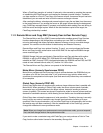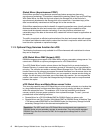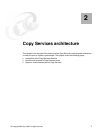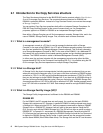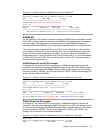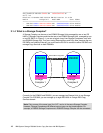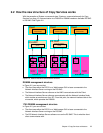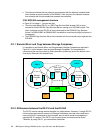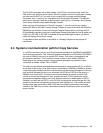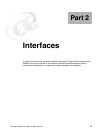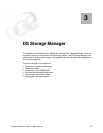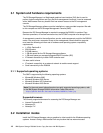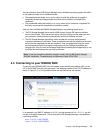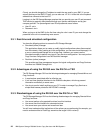Chapter 2. Copy Services architecture 13
The DS GUI is accessed with a Web browser. The DS GUI cannot save tasks (unlike the
ESS, which can), and you cannot use the DS GUI to initiate a series of saved tasks. Instead,
you must use the DS CLI. If you wish to use a single GUI to manage multiple Storage
Complexes, then, in the GUI, you must define all of the Storage Complexes. This definition
allows you to manage FlashCopy or Remote Mirror and Copy on, or between, every Storage
Unit in every defined and accessible Storage Complex.
When you look at the structure in Figure 2-2 on page 11, you can see that you need a
working DS SMC or DS HMC in every Storage Complex to communicate with the DS6000 or
DS8000 for that complex. For an inter-Storage Complex Remote Mirror and Copy, the DS
GUI establishes sessions to the source and targets Storage Complexes to show all paths and
LUNS. If no DS HMC or DS SMC is available at the remote Storage Complex, you cannot
select this Storage Complex as a target.
It is possible to have two SMCs or two HMCs in a Storage Complex for the purpose of
redundancy.
2.3 System z communication path for Copy Services
In a z/OS environment, you can issue Copy Services commands to the DS6000 and DS8000
via inband communication. This is done by sending commands via a FICON® (or ESCON® in
the case of DS8000) host link to a conduit CKD volume. From there it gets passed to the
microcode for execution. This is exactly the same as what is done with an ESS 800.
Depending on the operating system, various software packages are available to issue
commands; examples include TSO or ICKDSF.
The ability to send inband commands does not necessarily mean that the DS CLI or DS GUI
do not have a role to play. To be able to issue a command to a DS6000 or DS8000, a System
z operating system needs to be able to communicate with the relevant Storage Unit. We may
have a remote Storage Unit that is not connected via FICON (or ESCON in the case of a
DS8000) to an active z/OS. This means we would not be able to access a conduit CKD
volume on the remote Storage Unit. Now, provided we have TCP/IP connectivity and an
appropriate management station (such as a Windows host with a Web browser or DS CLI
installed), we could use the DS CLI or the DS GUI to manage the remote Storage Unit. We
could then use inband commands to manage the local Storage Unit. If the remote and local
Storage Units were connected by RMC links, then we could also send some commands
inband via the RMC links, such as commands to establish FlashCopies of the remote RMC
target volumes.



